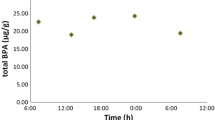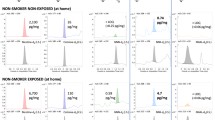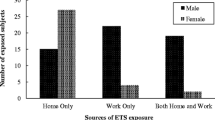Summary
Manufacture of bidis — the Indian version of cigarettes — is one of the largest cottage industries in India. Bidi rollers handle 225–450 g of bidi tobacco per day and inhale tobacco dust and volatile components present in the work environment. Since tobacco is known to be mutagenic and carcinogenic, urinary cotinine was estimated in bidi rollers and control subjects as an index of tobacco-specific exposure while the concentration of urinary thioethers was determined to ascertain exposure to electrophilic moieties. Detection of cotinine in urine samples from bidi rollers with no tobacco habits indicated that occupational exposure leads to cutaneous absorption of tobacco constituents and the resultant increase in exposure to alkylating agents was evident from elevated urinary thioether levels.
Similar content being viewed by others
References
Aringer L, Lidums V (1988) Influence of diet and other factors on urinary levels of thioethers. Int Arch Occup Environ Health 61:123–130
Bagwe AN, Bhisey RA (1991) Mutagenicity of processed bidi tobacco: possible relevance to bidi industry workers. Mutat Res 261:93–99
Bowman ER, Turnbull LB, McKennis H Jr (1959) Metabolism of nicotine in the human and excretion of pyridine compounds by smokers. J Pharmacol Exp Ther 127:92–95
Chasseaud LF (1979) The role of glutathione and glutathione S-transferase in the metabolism of chemical carcinogens and other electrophilic agents. Adv Cancer Res 29:175–275
Gehlbach SH, Ferry LD, Williams WA, Freeman JI, Langone JJ, Peta LV, Van Vunakis H (1975) Nicotine absorption by workers harvesting green tobacco. Lancet 1:478–480
Ghosh SK, Parikh JR, Gokani VN, Rao NM, Doctor PB (1985) Occupational health problems among tobacco processing workers: a preliminary study. Arch Environ Health 40:318–321
Heinonen T, Kytonieme V, Sorsa M, Vainio H (1983) Urinary excretion of thioethers among low-tar and medium-tar cigarette smokers. Int Arch Occup Environ Health 52:11–16
Henderson PT, van Doorn R, Leijdekkers CM, Bos RP (1984) Excretion of thioethers in urine after exposure to electrophilic chemicals. In: Berlin A, Draper M, Hemminki K, Vainio H (eds) Monitoring human exposure to carcinogenic and mutagenic agents. IARC Sc Publ No 59. International Agency for Research on Cancer, Lyon, pp 173–185
IARC (1985) IARC monographs on the evaluation of the carcinogenic risk of chemicals to humans, vol 37. Tobacco habits other than smoking; betel quid and areca-nut chewing; and some related nitrosamines. International Agency for Research on Cancer, Lyon
IARC (1986) IARC monographs on the evaluation of the carcinogenic risk of chemicals to humans, vol 33. Tobacco smoking. International Agency for Research on Cancer, Lyon
Jaisani BG (1989) Possible substitues and alternate uses of bidi tobacco. In: Sanghvi LD, Notani PN (eds) Tobacco and health — the Indian scene. UICC, Tata Memorial Centre, Bombay, pp 207–215
Kilpikari I, Savolainen H (1982) Increase in urinary thioether excretion in new rubber workers. Br J Ind Med 37:401–403
Lafuente A, Mallol J (1987) Urinary thioethers in workers exposed to asphalt: an impairment of glutathione S-transferase activity. J Toxicol Environ Health 21:533–534
Matsukura S, Taminato T, Kitano N, et al (1984) Effects of environmental tobacco smoke on urinary cotinine excretion in non-smokers: evidence for passive smoking. N Engl J Med 311:828–832
Peach H, Morris RW, Ellard GA, Jenner PJ (1986) A simple, inexpensive urine test of smoking. In: Zaridze DG, Peto R (eds) Tobacco — a major international health hazard. IARC Sc Publ No 74, International Agency for Research on Cancer, Lyon, pp 183–193
Seutter-Berlage F, Van Dorp HL, Kosse HG, Henderson PTG (1977) Urinary mercapturic acid excretion as a biological parameter of exposure to alkylating agents. Int Arch Occup Environ Health 39:45–51
Sinues B, Izquierdo M, Perez Viguera J (1990) Chromosome aberrations and urinary thioethers in smokers. Mutat Res 240:289–293
Vainio H, Savolainen H, Kilpikari I (1978) Urinary thioethers of employees of a chemical plant. Br J Ind Med 35:232–234
Varleg H (ed) (1967) Practical clinical biochemistry, 4th edn. Heinemann London; Interscience, New York
Wald N, Ritchie C (1984) Validation of studies on lung cancer in non-smokers married to smokers. Lancet 1:1067
Wilcox RG, Hughes J, Roland J (1979) Verification of smoking history in patients after infarction using urinary nicotine and cotinine measurements. Br Med J 11:1026–1028
Author information
Authors and Affiliations
Rights and permissions
About this article
Cite this article
Govekar, R.B., Bhisey, R.A. Elevated urinary thioether excretion among bidi rollers exposed occupationally to processed tobacco. Int. Arch Occup Environ Heath 64, 101–104 (1992). https://doi.org/10.1007/BF00381476
Received:
Accepted:
Issue Date:
DOI: https://doi.org/10.1007/BF00381476




